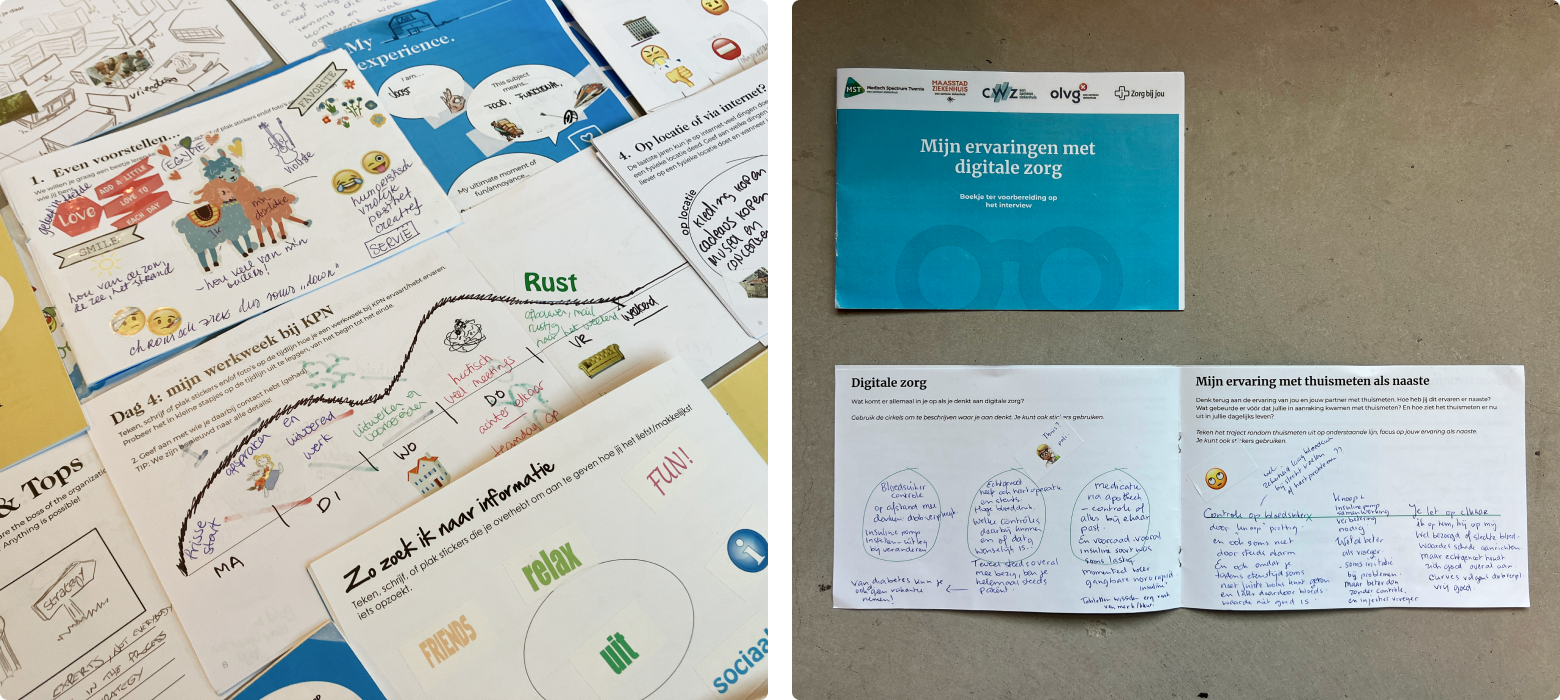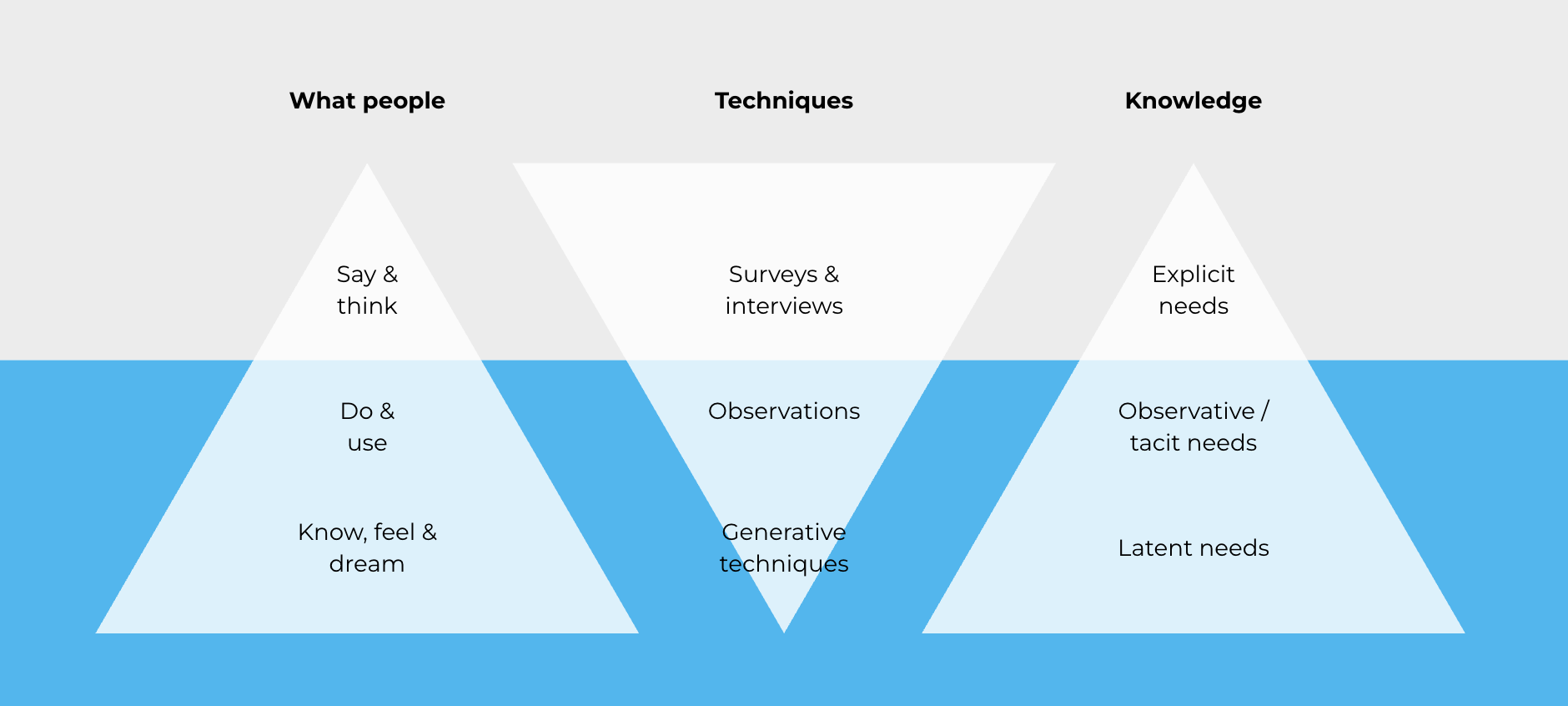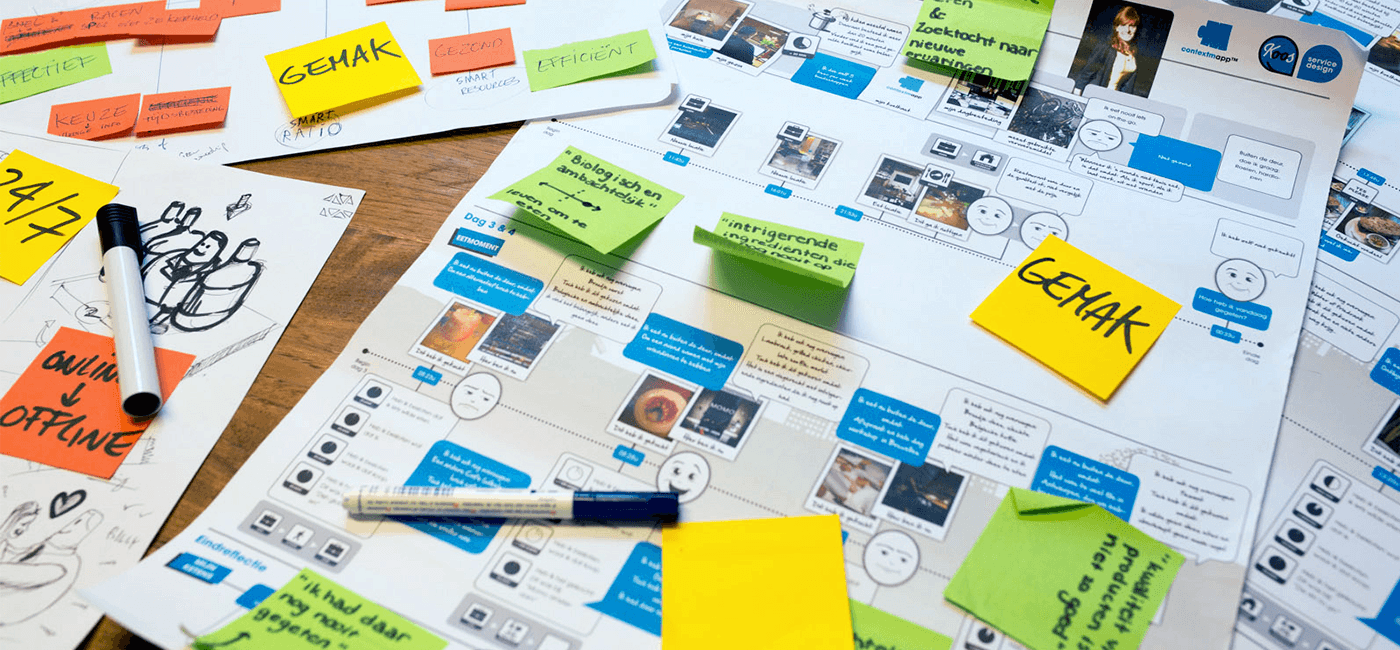What is Context Mapping?
Context mapping is a research method we use to gain deeper insights into users’ needs, values, fears, and aspirations regarding the experience of a certain topic, product or service. Developed at the Faculty of Industrial Design Engineering at Delft University of Technology, it engages users to express their experiences, thoughts and feelings through creative exercises, like (photo) diaries, mood boards, and card sorting. It complements traditional research methods such as interviews, observational studies, or focus groups.
This method is particularly valuable in the exploratory phase of the innovation process, where understanding the users’ world is crucial for identifying unmet needs and opportunities for design.

The Value of Context Mapping
Applying context mapping is beneficial on various levels of an organisation.
For Researchers: Uncovering Latent Needs
It enables researchers to develop a deeper, more comprehensive understanding of the user since it allows them to uncover needs and values that users may not consciously recognise or express.
It is especially useful for examining (socially) complex or emotionally sensitive topics, where individuals often struggle to articulate their thoughts and feelings. By offering tangible tools for sharing experiences and emotions, context mapping facilitates open, meaningful conversations with researchers.
For Design Teams: Inspiring Innovation
For design teams, context mapping is a valuable source of inspiration for developing innovative solutions. It provides input for foundational design guidelines, ensuring that products and services meet real user needs. Additionally, it improves empathy by helping designers immerse themselves in the user’s world.
For the Business: Improved product-market fit
By grounding design and business decisions in authentic user insights, context mapping increases the likelihood of market acceptance, reduces the risk of a product failure and enhances user satisfaction. These insights support the launch of unique products and services that resonate deeply with the target audience, which helps strengthen the brand’s competitive advantage and builds long-term customer loyalty.
The proof is in the pudding
We are often asked to design for these complex challenges, and context mapping always helps us understand people’s experiences on a deeper level and design solutions that resonate. A couple of examples:
- We supported RAK, a consortium of healthcare providers, in improving the transition towards a care home for elderly people. A stressful and emotionally heavy experience for everyone involved.
- In our collaboration with KPN, we dived into creating an experience for financially troubled customers that allows them to pay their bills more emphatically.
- Together with VGZ and BENU we designed a solution reducing stress for patients and pharmacy staff through smoother medicine switches.

How does Context Mapping work?
When conducting user research, we can uncover different levels of knowledge. While traditional methods, such as interviews, help reveal explicit needs, context mapping dives deeper into latent and unspoken ones. It facilitates the exploration of needs, values, fears, aspirations, and ideas that may not emerge through direct questioning. These deeper layers of needs and values often play a significant role in people’s lives, providing a robust foundation for developing future products and services.
This is where generative tools should be used–to support people in tapping into this latent, often difficult-to-express knowledge. The core concept behind these tools is that individuals create something and then talk about it. It helps individuals express their experiences, thoughts, and feelings through rich visual and verbal materials, enabling them to become more aware of their needs and articulate them more effectively.
Reflecting on current and past experiences is essential before exploring the desires, dreams, and fears that shape users’ future needs. This process helps users recognise what holds value for them today, making it easier to envision and articulate what will be important to them in the future.

Examples of Generative tools
Generative tools allow participants to capture and explain their experiences in rich, nuanced ways. But there is one rudimentary rule: all stimulative material has to be ambiguous in all possible ways. Participants are allowed to free-flow with whatever they come up with as this is the only way of uncovering true motivations and needs. This will help you understand what is important for them, without making assumptions.
Below, we briefly dive into 5 tools we often use to enrich our qualitative research. There are no clear instructions on what tool to use and when. This depends on your research topic, target group, and what you aim to learn. The fun part is that you can tweak existing tools or develop your own that fits your research the best, so get creative!

- Booklet:
Participants document their daily activities, thoughts, and experiences over a period of time in a booklet format. Add blank mindmaps, storylines, and pros & cons pages for people to fill in. It helps gain rich insights into their context, routines, and needs.
- Moodboards:
Visual boards with images, colours, and materials to express emotions, ideas, or a particular style. Helps participants and designers articulate intangible feelings or preferences.
- Lego Serious Play:
A hands-on method using Lego bricks to visualize and express ideas, challenges, and solutions. It fosters creativity and encourages storytelling through tangible models.
- Photo Study:
Participants capture pictures of their environment or experiences to share meaningful insights. It helps designers understand users’ lives from their perspective.
- Card Sorting:
A method where participants categorise cards (representing values, concepts, tasks, or ideas) in ways that make sense to them. It helps designers understand mental models and prioritise information or features.
How to integrate Context Mapping into your research
Integrating context mapping into your research requires a structured process. Below, we describe a step-by-step approach incorporating practical tips to maximise the value of user insights:
- Preparation
Begin by defining clear objectives for your research. Clearly articulate your goals and what you aim to learn to ensure focused data collection. Design the study and prepare the generative tool(s). Choose tools that are appropriate for your target audience and research goals, and get creative with the exercises to make them engaging.
- Data Collection
Recruit the right participants for your study. When sharing generative tools, explain the purpose of the research, what participants can expect, and how these tools help them prepare. Participants use the tools to capture aspects of their experiences relevant to the research topic. This self-documentation encourages reflection and provides authentic insights into their contexts while mentally preparing them for interviews or workshops.
- Generative Interviews and Sessions
Conduct in-depth interviews and/or workshops where participants discuss their documented experiences (e.g. diaries, booklets). It is also possible to use generative tools directly in your interview or workshop and let participants engage in creative activities, like card sorting or mood board-making to express their thoughts and feelings.
- Analysis
Analyze the collected data to identify patterns, themes, and insights. This step reveals deeper user needs and uncovers opportunities for design innovation. To validate your findings, consider using quantitative methods such as surveys. This step strengthens your insights and helps prioritise design decisions.
- Application
Ensure the insights are actionable by translating them into tangible outcomes, such as design guidelines or user personas, guiding the development of concepts and strategies closely aligned with user contexts and experiences.
Turning insights into impact with Context Mapping
Context mapping is more than just a research tool—it is a gateway to understanding the complexities of user needs and behaviours. This method bridges the gap between design aspirations and real-world relevance by uncovering hidden insights and engaging users in co-creation.
Whether working on the next big innovation or refining an existing service, context mapping equips you with the empathy and clarity needed to make impactful decisions. Dive into this approach, and watch your designs transform into solutions that truly resonate with your customers.


